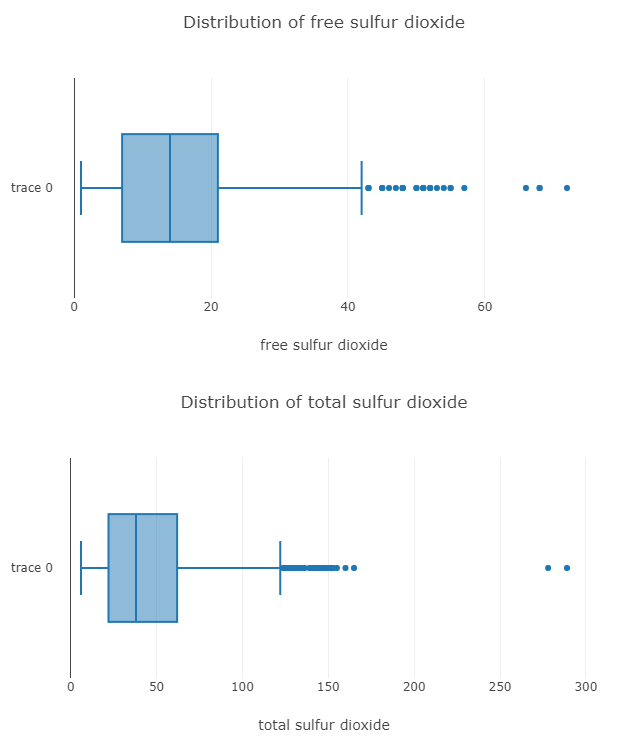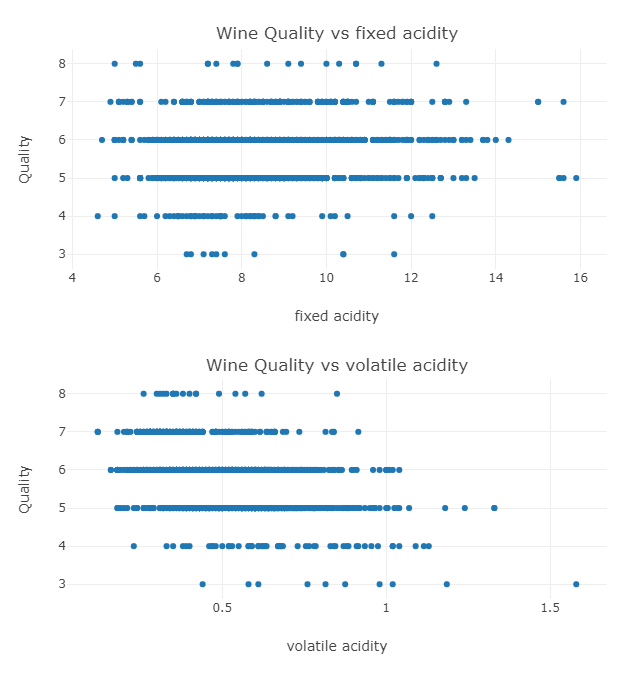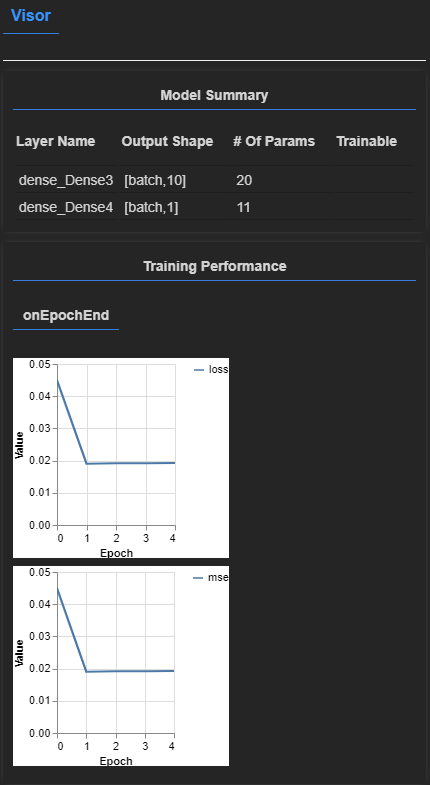はじめに
今回は、TensorFlowJSとGridDBを使ってモデルを学習し、赤ワインの品質を予測します。このチュートリアルでは、以下のNodeJS用ライブラリを使用します。
- TensorflowJS - モデルのトレーニングに使用します。
- DanfoJS - DataFrameの操作に使用します。
記事の全コードはこちら をご覧ください。
データサイエンスやMLの実験を容易にするためにはNode Notebooksを使った作業が便利です。Visual Studio CodeはNode Notebooksをサポートする素晴らしいエディタなので、この記事ではそれを使用することにします。注: Danfo JS と Tensorflow JS は最低でもnodeのバージョン 12 が必要で、griddb はnodeのバージョン 10 で動きます。
const dfd = require("danfojs-node")
var fs = require('fs');
const tf = dfd.tensorflow
const tfvis = require('@tensorflow/tfjs-vis')
使用するデータセットは、This Kaggle Datasetのものを使用する予定です。
まずは、データセットをCSVで読み込み、GridDBに挿入するところから始めます。
GridDBにデータをロードし、GridDBからデータをフェッチする
まず、GridDB サーバに接続します。同じマシン(localhost)上で動作させています。
var griddb = require('griddb_node');
const createCsvWriter = require('csv-writer').createObjectCsvWriter;
const csvWriter = createCsvWriter({
path: 'out.csv',
header: [
{id: "fixed acidity", title:"fixed acidity"},
{id: "volatile acidity", title:"volatile acidity"},
{id: "citric acid", title:"citric acid"},
{id: "residual sugar", title:"residual sugar"},
{id: "chlorides", title:"chlorides"},
{id: "free sulfur dioxide", title:"free sulfur dioxide"},
{id: "total sulfur dioxide" , title:"total sulfur dioxide"},
{id: "density", title:"density"},
{id: "pH", title:"pH"},
{id: "sulphates", title:"sulphates"},
{id: "alcohol", title:"alcohol"},
{id: "quality", title:"quality"}
]
});
const factory = griddb.StoreFactory.getInstance();
const store = factory.getStore({
"host": '239.0.0.1',
"port": 31999,
"clusterName": "defaultCluster",
"username": "admin",
"password": "admin"
});
// For connecting to the GridDB Server we have to make containers and specify the schema.
const conInfo = new griddb.ContainerInfo({
'name': "redwinequality",
'columnInfoList': [
["name", griddb.Type.STRING],
["fixedacidity", griddb.Type.DOUBLE],
["volatileacidity", griddb.Type.DOUBLE],
["citricacid", griddb.Type.DOUBLE],
["residualsugar", griddb.Type.DOUBLE],
["chlorides", griddb.Type.DOUBLE],
["freesulfurdioxide", griddb.Type.INTEGER],
["totalsulfurdioxide", griddb.Type.INTEGER],
["density", griddb.Type.DOUBLE],
["pH", griddb.Type.DOUBLE],
["sulphates", griddb.Type.DOUBLE],
["alcohol", griddb.Type.DOUBLE],
["quality", griddb.Type.INTEGER],
],
'type': griddb.ContainerType.COLLECTION, 'rowKey': true
});
// ////////////////////////////////////////////
const csv = require('csv-parser');
const fs = require('fs');
var lst = []
var lst2 = []
var i =0;
fs.createReadStream('./dataset/winequality-red.csv')
.pipe(csv())
.on('data', (row) => {
lst.push(row);
})
.on('end', () => {
var container;
var idx = 0;
for(let i=0;i<lst.length;i++){
lst[i]["fixed acidity"] = parseFloat(lst[i]["fixed acidity"])
lst[i]['volatile acidity'] = parseFloat(lst[i]["volatile acidity"])
lst[i]['citric acid'] = parseFloat(lst[i]["citric acid"])
lst[i]['residual sugar'] = parseFloat(lst[i]["residual sugar"])
lst[i]['chlorides'] = parseFloat(lst[i]["chlorides"])
lst[i]['free sulfur dioxide'] = parseInt(lst[i]["free sulfur dioxide"])
lst[i]['total sulfur dioxide'] = parseInt(lst[i]["total sulfur dioxide"])
lst[i]['density'] = parseFloat(lst[i]["density"])
lst[i]['pH'] = parseFloat(lst[i]["pH"])
lst[i]['sulphates'] = parseFloat(lst[i]["sulphates"])
lst[i]['alcohol'] = parseFloat(lst[i]["alcohol"])
lst[i]['quality'] = parseFloat(lst[i]["quality"])
console.log(parseFloat(lst[i]["fixed acidity"]))
store.putContainer(conInfo, false)
.then(cont => {
container = cont;
return container.createIndex({ 'columnName': 'name', 'indexType': griddb.IndexType.DEFAULT });
})
.then(() => {
idx++;
container.setAutoCommit(false);
return container.put([String(idx), lst[i]['fixed acidity'],lst[i]["volatile acidity"],lst[i]["citric acid"],lst[i]["residual sugar"],lst[i]["chlorides"],lst[i]["free sulfur dioxide"],lst[i]["total sulfur dioxide"],lst[i]["density"],lst[i]["pH"],lst[i]["sulphates"],lst[i]["alcohol"],lst[i]["quality"]]);
})
.then(() => {
return container.commit();
})
.catch(err => {
if (err.constructor.name == "GSException") {
for (var i = 0; i < err.getErrorStackSize(); i++) {
console.log("[", i, "]");
console.log(err.getErrorCode(i));
console.log(err.getMessage(i));
}
} else {
console.log(err);
}
});
}
store.getContainer("redwinequality")
.then(ts => {
container = ts;
query = container.query("select *")
return query.fetch();
})
.then(rs => {
while (rs.hasNext()) {
let rsNext = rs.next();
lst2.push(
{
'fixed acidity': rsNext[1],
"volatile acidity": rsNext[2],
"citric acid": rsNext[3],
"residual sugar": rsNext[4],
"chlorides": rsNext[5],
"free sulfur dioxide": rsNext[6],
"total sulfur dioxide": rsNext[7],
"density": rsNext[8],
"pH": rsNext[9],
"sulphates": rsNext[10],
"alcohol": rsNext[11],
"quality": rsNext[12]
}
);
}
csvWriter
.writeRecords(lst2)
.then(()=> console.log('The CSV file was written successfully'));
return
}).catch(err => {
if (err.constructor.name == "GSException") {
for (var i = 0; i < err.getErrorStackSize(); i++) {
console.log("[", i, "]");
console.log(err.getErrorCode(i));
console.log(err.getMessage(i));
}
} else {
console.log(err);
}
});
});
そして、同じコードでGridDBからデータを取得し、csvファイルに書き込んでいます。このようにした理由は、プロジェクトファイルはnodeのバージョン12で動作し、GridDBのコードはnodeのバージョン10で動作するからです。
let df = await dfd.readCSV("./out.csv")
次に、node notebookでcsvファイルを読み込み、その上で探索的データ解析を行います。その後、前処理とモデリングに移行することができます。
GridDBから取得したデータをdfという変数に格納し、データフレームを作成しました。
探索的データ解析
EDAの段階では、データがどのようなものかを把握するために、データをチェックします。一番簡単なのは、何行あって、何列あって、それぞれの列のデータ型は何なのかを確認することです。
データフレームの形状を確認します。1599行と12列のデータであることがわかります。
console.log(df.shape)
// Output
// [ 1599, 12 ]
では、列を確認します。それぞれの行に異なる数量が与えられています。そして、目標にする品質変数です。
出力
['fixed acidity','volatile acidity','citric acid','residual sugar','chlorides','free sulfur dioxide', 'total sulfur dioxide','density','pH','sulphates','alcohol','quality']
danfoJSのprint関数は最大10行の印刷が可能なので、列型の印刷は2回に分けて行わなければなりません。
df.loc({columns:['fixed acidity',
'volatile acidity',
'citric acid',
'residual sugar',
'chlorides',
'free sulfur dioxide','total sulfur dioxide',
'density']}).ctypes.print()
// Output
// ╔══════════════════════╤═════════╗
// ║ fixed acidity │ float32 ║
// ╟──────────────────────┼─────────╢
// ║ volatile acidity │ float32 ║
// ╟──────────────────────┼─────────╢
// ║ citric acid │ float32 ║
// ╟──────────────────────┼─────────╢
// ║ residual sugar │ float32 ║
// ╟──────────────────────┼─────────╢
// ║ chlorides │ float32 ║
// ╟──────────────────────┼─────────╢
// ║ free sulfur dioxide │ int32 ║
// ╟──────────────────────┼─────────╢
// ║ total sulfur dioxide │ int32 ║
// ╟──────────────────────┼─────────╢
// ║ density │ float32 ║
// ╚══════════════════════╧═════════╝
df.loc({columns:['pH',
'sulphates',
'alcohol',
'quality']}).ctypes.print()
// Output
// ╔═══════════╤═════════╗
// ║ pH │ float32 ║
// ╟───────────┼─────────╢
// ║ sulphates │ float32 ║
// ╟───────────┼─────────╢
// ║ alcohol │ float32 ║
// ╟───────────┼─────────╢
// ║ quality │ int32 ║
// ╚═══════════╧═════════╝
ここで、すべての列の統計の要約を見て、その最小値、最大値、平均値、標準偏差などを確認します。
df.loc({columns:['fixed acidity',
'volatile acidity',
'citric acid',
'residual sugar',
'chlorides',
'free sulfur dioxide','total sulfur dioxide',
'density']}).describe().round(2).print()
// Output
// ╔════════════╤═══════════════════╤═══════════════════╤═══════════════════╤═══════════════════╤═══════════════════╤═══════════════════╤═══════════════════╤═══════════════════╗
// ║ │ fixed acidity │ volatile acidity │ citric acid │ residual sugar │ chlorides │ free sulfur dio… │ total sulfur di… │ density ║
// ╟────────────┼───────────────────┼───────────────────┼───────────────────┼───────────────────┼───────────────────┼───────────────────┼───────────────────┼───────────────────╢
// ║ count │ 1599 │ 1599 │ 1599 │ 1599 │ 1599 │ 1599 │ 1599 │ 1599 ║
// ╟────────────┼───────────────────┼───────────────────┼───────────────────┼───────────────────┼───────────────────┼───────────────────┼───────────────────┼───────────────────╢
// ║ mean │ 8.32 │ 0.53 │ 0.27 │ 2.54 │ 0.09 │ 15.87 │ 46.47 │ 1 ║
// ╟────────────┼───────────────────┼───────────────────┼───────────────────┼───────────────────┼───────────────────┼───────────────────┼───────────────────┼───────────────────╢
// ║ std │ 1.74 │ 0.18 │ 0.19 │ 1.41 │ 0.05 │ 10.46 │ 32.9 │ 0 ║
// ╟────────────┼───────────────────┼───────────────────┼───────────────────┼───────────────────┼───────────────────┼───────────────────┼───────────────────┼───────────────────╢
// ║ min │ 4.6 │ 0.12 │ 0 │ 0.9 │ 0.01 │ 1 │ 6 │ 0.99 ║
// ╟────────────┼───────────────────┼───────────────────┼───────────────────┼───────────────────┼───────────────────┼───────────────────┼───────────────────┼───────────────────╢
// ║ median │ 7.9 │ 0.52 │ 0.26 │ 2.2 │ 0.08 │ 14 │ 38 │ 1 ║
// ╟────────────┼───────────────────┼───────────────────┼───────────────────┼───────────────────┼───────────────────┼───────────────────┼───────────────────┼───────────────────╢
// ║ max │ 15.9 │ 1.58 │ 1 │ 15.5 │ 0.61 │ 72 │ 289 │ 1 ║
// ╟────────────┼───────────────────┼───────────────────┼───────────────────┼───────────────────┼───────────────────┼───────────────────┼───────────────────┼───────────────────╢
// ║ variance │ 3.03 │ 0.03 │ 0.04 │ 1.99 │ 0 │ 109.41 │ 1082.1 │ 0 ║
// ╚════════════╧═══════════════════╧═══════════════════╧═══════════════════╧═══════════════════╧═══════════════════╧═══════════════════╧═══════════════════╧═══════════════════╝
df.loc({columns:['pH','sulphates','alcohol','quality']}).describe().round(2).print()
// Output
// ╔════════════╤═══════════════════╤═══════════════════╤═══════════════════╤═══════════════════╗
// ║ │ pH │ sulphates │ alcohol │ quality ║
// ╟────────────┼───────────────────┼───────────────────┼───────────────────┼───────────────────╢
// ║ count │ 1599 │ 1599 │ 1599 │ 1599 ║
// ╟────────────┼───────────────────┼───────────────────┼───────────────────┼───────────────────╢
// ║ mean │ 3.31 │ 0.66 │ 10.42 │ 5.64 ║
// ╟────────────┼───────────────────┼───────────────────┼───────────────────┼───────────────────╢
// ║ std │ 0.15 │ 0.17 │ 1.07 │ 0.81 ║
// ╟────────────┼───────────────────┼───────────────────┼───────────────────┼───────────────────╢
// ║ min │ 2.74 │ 0.33 │ 8.4 │ 3 ║
// ╟────────────┼───────────────────┼───────────────────┼───────────────────┼───────────────────╢
// ║ median │ 3.31 │ 0.62 │ 10.2 │ 6 ║
// ╟────────────┼───────────────────┼───────────────────┼───────────────────┼───────────────────╢
// ║ max │ 4.01 │ 2 │ 14.9 │ 8 ║
// ╟────────────┼───────────────────┼───────────────────┼───────────────────┼───────────────────╢
// ║ variance │ 0.02 │ 0.03 │ 1.14 │ 0.65 ║
// ╚════════════╧═══════════════════╧═══════════════════╧═══════════════════╧═══════════════════╝
さて、分布を可視化するために、箱ひげ図とヒストグラムを使用します。
## Distribution of Column Values
const { Plotly } = require('node-kernel');
let cols = df.columns
for(let i = 0; i < cols.length; i++)
{
let data = [{
x: df[cols[i]].values,
type: 'box'}];
let layout = {
height: 400,
width: 700,
title: 'Distribution of '+cols[i],
xaxis: {title: cols[i]}};
// There is no HTML element named `myDiv`, hence the plot is displayed below.
Plotly.newPlot('myDiv', data, layout);
}
そして、ここに2つの列の箱ひげ図があります。
品質と他のカラムの散布図をプロットします。
## Scatter Plot between Wine Quality and Column
let cols = [...cols]
cols.pop('quality')
for(let i = 0; i < cols.length; i++)
{
let data = [{
x: df[cols[i]].values,
y: df['quality'].values,
type: 'scatter',
mode: 'markers'}];
let layout = {
height: 400,
width: 700,
title: 'Red Wine Quality vs '+cols[i],
xaxis: {title: cols[i]},
yaxis: {title: 'Quality'}};
// There is no HTML element named `myDiv`, hence the plot is displayed below.
Plotly.newPlot('myDiv', data, layout);
}
2つの列の例に対するプロットは以下の通りです。
プロットを見ると、これらの列はワインの品質を予測するために使用することができ、間違いなくモデルを作ることができると言えるでしょう。
データの前処理
データはほとんど整理されているので、NULL値を削除するだけです。
df_drop = df.dropNa({ axis: 0 }).loc({columns:['quality','density']})
モデル
入力層と出力層を1つずつ持つ単純なニューラルネットワークを作成します。
function createModel() {
// Create a sequential model
const model = tf.sequential();
// Add a single input layer
model.add(tf.layers.dense({inputShape: [1], units: 10, useBias: true}));
// Add an output layer
model.add(tf.layers.dense({units: 1, useBias: true}));
return model;
}
// Create the model
const model = createModel();
tfvis.show.modelSummary({name: 'Model Summary'}, model);
Model Summaryには、層と各層のニューロン数が表示されます。
モデルを作成したので、次にデータをテンソル形式に変換して、Tensorflowがモデルを学習できるようにする必要があります。
function convertToTensor(data) {
// Wrapping these calculations in a tidy will dispose any
// intermediate tensors.
return tf.tidy(() => {
// Step 1. Shuffle the data
tf.util.shuffle(data);
// Step 2. Convert data to Tensor
const inputs = data.map(d => d[0]);
const labels = data.map(d => d[1]);
// console.log(inputs);
// console.log(data);
const inputTensor = tf.tensor2d(inputs, [inputs.length, 1]);
const labelTensor = tf.tensor2d(labels, [labels.length, 1]);
//Step 3. Normalize the data to the range 0 - 1 using min-max scaling
const inputMax = inputTensor.max();
const inputMin = inputTensor.min();
const labelMax = labelTensor.max();
const labelMin = labelTensor.min();
const normalizedInputs = inputTensor.sub(inputMin).div(inputMax.sub(inputMin));
const normalizedLabels = labelTensor.sub(labelMin).div(labelMax.sub(labelMin));
return {
inputs: normalizedInputs,
labels: normalizedLabels,
// Return the min/max bounds so we can use them later.
inputMax,
inputMin,
labelMax,
labelMin,
}
});
}
そして、モデルがどのように学習するかを指定する関数を作成します。ここでは、損失を予測値と実際の品質値の間の平均二乗誤差とします。
async function trainModel(model, inputs, labels) {
// Prepare the model for training.
model.compile({
optimizer: "adam",
loss: tf.losses.meanSquaredError,
metrics: ['mse'],
});
const batchSize = 2;
const epochs = 5;
await model.fit(inputs, labels, {
batchSize,
epochs,
shuffle: true,
callbacks: tfvis.show.fitCallbacks(
{ name: 'Training Performance' },
['loss', 'mse'],
{ height: 200, callbacks: ['onEpochEnd'] }
)
});
return model;
}
最後に、モデルを学習させます。デモのため、エポック数は5のみに設定しました。これはモデルやデータによって設定する必要があります。また、データセットの最初の100行はテスト用に残しておきます。
const tensorData = convertToTensor(df_drop.values)
const {inputs, labels} = tensorData;
// Train the model
let model = await trainModel(model, inputs.slice([100],[-1]), labels.slice([100],[-1]));
console.log('Done Training');
// Output
// Epoch 1 / 5
// Epoch 2 / 5
// Epoch 3 / 5
// Epoch 4 / 5
// Epoch 5 / 5
// Done Training
// 11819ms 7392us/step - loss=0.0450 mse=0.0450
// 10833ms 6775us/step - loss=0.0190 mse=0.0190
// 10878ms 6803us/step - loss=0.0192 mse=0.0192
// 10642ms 6655us/step - loss=0.0192 mse=0.0192
// 11025ms 6895us/step - loss=0.0193 mse=0.0193
モデルの学習が完了したので、モデルを評価することができます。評価にはevaluate関数を使用し、テストセット(学習時に残った最初の100行のデータセット)でモデルをテストすることができます。
model.evaluate(inputs.slice([0],[100]), labels.slice([0],[100]))[0].print() // Loss
model.evaluate(inputs.slice([0],[100]), labels.slice([0],[100]))[1].print() // Metric
// Output
// Tensor
// 0.018184516578912735
今回は、TensorflowJSとGridDBを組み合わせてモデルを学習し、予測を行う方法を学びました。



